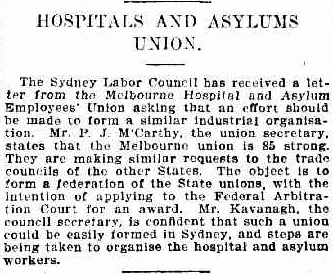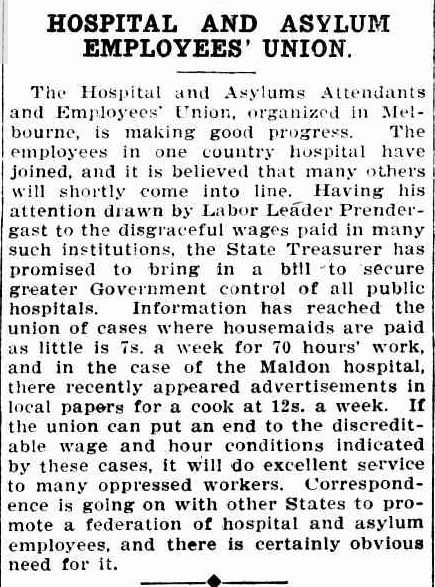The union was officially registered under the Commonwealth Arbitration Act on Wednesday, 12th April 1911.
The first President of the union was Walter E. Petersen, and the first Secretary was George James Pitt.
On its first day of its new found authority, the Victorian division handed a petition to then Premier John Murray underlining the poor pay and working conditions that employees were forced to endure.
At the time, workers in the health sector were paid according to an award that largely covered charities, owing to the nature of the vast majority of the nation's health providers being run by religious institutions.
Many of these complaints were longstanding, with some dating as far back as the late 1800's.
Gradually, the union was able to gain a lot of ground, with entitlements and conditions slowly improving. In 1913, the Public Service Board of NSW agreed to back pay many workers across the state, whilst considerations of the time such as lodging and quarters were also improved.
Inclusiveness was a bedrock of the union since its formation.
The New South Wales body chose the term employees as they felt it encompassed all workers of the health sector, and in 1914 the Victorian body changed its name to the Hospital Dispensary and Asylum Employees' Union of Australia (HDAEA) to incorporate the wider health sector.
Despite these efforts, and owing to the times, the bedrock of the membership of these two fledgling unions at the time was very much comprised of hospital staff and psychiatric care.
In 1917, the Wages Board was finally granted to health workers across the country after 6 years of tireless and hard campaigning - our first big win of many.

A call to arms from the south! - The Daily Telegraph, New South Wales, 6th October 1910

Enthusiasm abounds as workers in both Victoria and NSW join the newly formed union - The Worker, New South Wales, 24th November 1910